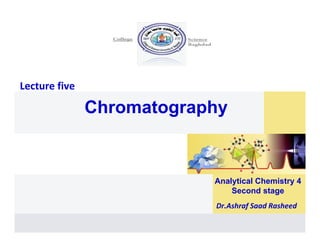
Lecture 5 analytical chemistry 4-second stage
- 1. Lecture five ChromatographyChromatography Analytical Chemistry 4 Second stage Dr.Ashraf Saad Rasheed
- 2. Paper and Thin-layer Chromatography • Chromatography is a technique for separating mixtures into their components in order to analyze, identify, purify, and/or quantify thecomponents in order to analyze, identify, purify, and/or quantify the mixture or components. Analyze Identify Separation Identify Purify Quantify 2
- 3. • Chromatography is used by scientists to: 1. Analyze–examine a mixture, its components, and their relations to one another. 2. Identify–determine the identity of a mixture or components based on known components. 3. Purify – separate components in order to isolate one of interest for further study. 4. Quantify – determine the amount of the mixture and/or the components present in the sample. 3
- 4. Paper Chromatography (PC): • Historically important technique used to separate amino acids, nucleotides and metabolites. As we learn from previous chromatographic separation involves TWO PHASES; • Mobile phase (gas or liquid)p (g q ) • Stationary phase (liquid or solid) • In paper chromatography, the mobile phases pass through the sample by CAPILLARY ACTION in the papersample by CAPILLARY ACTION in the paper. • Mobile phase = Solvents polar solvent mixture ( t th l)(eg. water:ethanol) • Stationary phase = Chromatography paper (cellulose-based paper) 4
- 5. • Paper chromatography is based on the separation of components mixture in the sample solution by the movement of a liquid (mobile phase) through the spaces of a porous material (filter paper) or a small diameter tubep p ( p p ) against the forces of gravity (i.e. by capillary action) and the degree to which a material (solute) dissolves into a liquid (solvent)- i.e. absorption. St. h Separation phase M bilMobile phaseMixture components Components Affinity to Stationary Phase Affinity to Phase y y Blue ‐‐‐‐‐‐‐‐‐‐‐‐‐‐‐‐ Insoluble in Phase Black Red Yellow 5 e o
- 6. • In principle, paper chromatography, like thin layer chromatography, substances are distributed between a stationary phase and a mobilesubstances are distributed between a stationary phase and a mobile phase. • The stationary phase is usually a piece of high quality filter paper. The mobile phase is a developing solution that travels up theThe mobile phase is a developing solution that travels up the stationary phase, carrying the samples with it. • Components of the sample will separate on the stationary phase according to how strongly they adsorb to the stationary phaseaccording to how strongly they adsorb to the stationary phase versus how much they dissolve in the mobile phase. 6
- 7. Solvent systems for PC applications: 7
- 8. • The filter paper holds the components until the solvent dissolves them and carries them up the filter paper. • The solvent travels up the filter paper by capillary action. 8
- 9. 1. The separation of components depends on their solubility with the solvent and their affinity to the solvent and filter papersolvent and their affinity to the solvent and filter paper. 2. The solvent can only move the components if they are soluble in it and the more soluble a component is the more there is available to move up the filter paperto move up the filter paper. 3. Solutes will dissolve into solvents that have similar properties. Polar solvents dissolve polar solutes and non-polar solvents dissolve non-polar solutes (Like dissolves like )dissolve non-polar solutes. (Like dissolves like.) • To measure how far each component travels, we calculate the retention factor (R value) of the sampleretention factor (Rf value) of the sample. • The Rf value is the ratio between how far the component travels and f (the distance the solvent travels from a common starting point (the origin).. 9
- 10. • If one of the sample components moves 2.5 cm up the paper and the solvent moves 5.0 cm, then the Rf value is 0.5. You can use Rft e so e t o es 5 0 c , t e t e f a ue s 0 5 ou ca use f values to identify different components as long as the solvent, temperature, pH, and type of paper remain the same. In the image below, the light blue shading represents the solvent and the dark blue spot is the chemical sample To calculate the Rf value, we use the equation: Rf =distance traveled by the sample component distance traveled by the solvent 2 52.5 cm Rf = = 0.5 5.0 cm 10